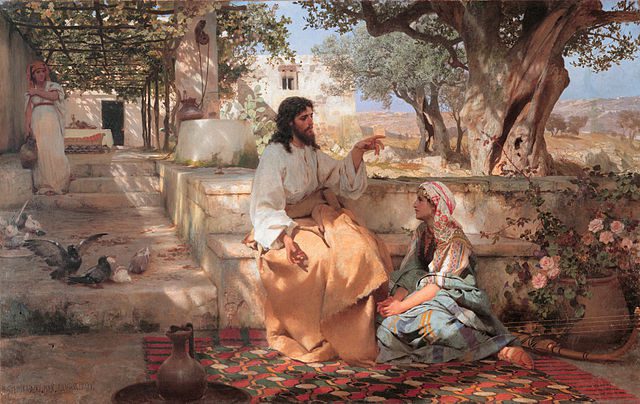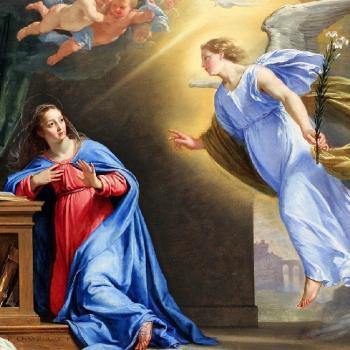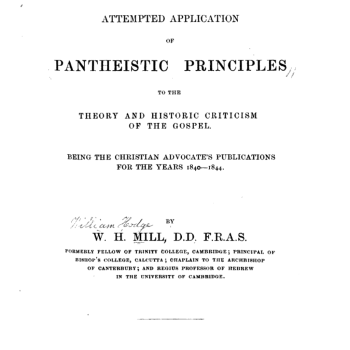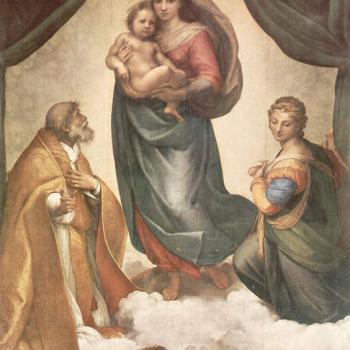Is This Proof that They Are His Siblings?

Christ in the House of Martha and Mary (1886), by Henryk Siemiradzki (1843-1902) [public domain / Wikimedia Commons]
* * * * *
(8-31-09)
* * * * *
This exchange occurred on the CHNI forum. The person who asked the questions is, by his own description, “Raised RC, denominational orphan, post-Protestant.” I suspect that he may have come up with this question through the influence of a Protestant source or direct challenge (but maybe not). He is seeking answers, and I gave a shot at providing what I thought was a decent Catholic reply to his query. As usual, when I try to answer a question, I learn a lot myself. That is one of the joys and benefits of apologetics. His words are in blue, others’ in green and purple, and mine in black.
* * * * *
Okay, so here’s an old question with (I think) a new twist. I’m now trying to come to terms with the Church’s teaching on the perpetual virginity of Mary and exactly who the ‘brothers’ of Jesus were. I’ve read all kinds of apologetics on the subject, but there’s one thing that no one seems to address that keeps nagging at me and I can’t piece together: why were the supposed brothers & sisters of Jesus, who were not Mary’s actual children commonly pictured in Scripture with her? Like I’ve said, I’ve read most of the common apologetic books and online material I could get my hands on so I don’t need all the common arguments repeated. I know the Greek word adelphos meant brother, and it was actually a transference of a middle-eastern phrase ‘brother’ since there was no word for [cousin] in Aramaic or Hebrew. My understanding is that after St. Jerome wrote his tract Against Helvidius, the Church has generally accepted that the brothers were probably Jesus’ cousins. However, for a theory to work, it has to coinhere – that is, all the parts have to fit together in a coherent way. But no apologists ever seem to explain why these ‘cousins’ of Jesus are commonly pictured with Mary.
In Matthew 12.46, it says Jesus’ mother and brothers are outside the house trying to speak with him, and in Matthew 13.55 these ‘cousins’ are listed together with Mary. This seems somewhat odd in a middle-eastern culture in which sons were more commonly listed as being the son of their father as Scripture often does. So I guess what I’m wondering is whether someone can point me to some good references to account for what is happening with these cousins who always seem to be hanging out with their aunt Mary? If one or two of them were listed or were going along for moral support it would make sense, but 6+ cousins listed with their auntie and all tagging along in a gaggle for moral support doesn’t really make a lot of sense. But perhaps there’s cultural info that I’m not aware of that someone can point me to that will make better sense of this picture. In contrast, I understand that in the earliest Church it was generally believed that these ‘brothers’ of Jesus were older children of Joseph (who was widowed) from a prior marriage (i.e. step-brothers to Jesus). This to me would make more sense – that step-brothers of Jesus would naturally be pictured and listed with their step-mother. It kind of puzzles me that most Catholic apologists (and the western Church) turned away from several hundred years of tradition at the time of St. Jerome to follow a new and novel idea that the ‘brothers’ were actually Jesus’ cousins. I find it odd that the Church made this sudden right turn away from a long held tradition, whereas in many instances something like this is used as an argument that something should be believed: because the Church had held to it for hundreds of years from apostolic days. Any thoughts & suggestions as to how to think about all this?Am I free to hold to either viewpoint regarding who the brothers were if I came into the Church? I’m puzzled because even the catechism indicates the brothers were sons of another Mary (500) – which makes me think this has now been definitively defined. Even if not, I would still feel like the odd man out since everyone seems to be on the ‘cousins’ bandwagon, but from what I can see there’s a few serious holes in that that viewpoint that no seems to address from an apologetics perspective which leaves me perplexed. Any help and insight would be appreciated.
If Mary had male children other than Jesus, it would have been a HUGE insult to them for Jesus to entrust her care to the apostle John who was not a “blood” relation.
Unfortunately, this is the standard Catholic response which I’ve seen many times, but doesn’t really answer MY question above. Why were the supposed cousins of Jesus always pictured as hanging out with Mary? I find the standard Catholic response to this question is not an answer at all. Instead, all there seems to be to this question so far is more perplexing questions thrown my way – but I’m hoping someone will be actually be able to answer the questions rather than evading them with more questions. All I want is the truth & to get to the bottom of things wherever that may take me. Thanks!
Have you had a chance to go to www.biblechristiansociety.com? His questions like yours go even farther into the logic of letting our minds go. Here lets take one of his arguments very similar to the unanswered loose ends curiosity you have discovered. Also, we see from Mt. 27:55-56, that the James and Joses mentioned in Mark 6 as the “brothers” of Jesus, are actually the sons of another Mary. And, one other passage to consider is Acts 1:14-15, “[The Apostles] with one accord devoted themselves to prayer, together with the women and Mary the mother of Jesus and with His brothers…the company of persons was in all about a hundred and twenty.” A company of 120 persons composed of the Apostles, Mary, the women, and the “brothers” of Jesus. Let’s see there were 11 Apostles at the time. Jesus’ mother makes 12. The women, probably the same three women mentioned in Matthew 27, but let’s say it was maybe a dozen or two, just for argument’s sake. So that puts us up to 30 or 40 or so. So that leaves the number of Jesus’ brothers at about 80 or 90! Do you think Mary had 80 or 90 children? She would have been in perpetual labor! No, Scripture does not contradict the teaching of the Catholic Church about the “brothers” of Jesus, when Scripture is properly interpreted in context.
The step-brothers scenario would be one plausible answer. I believe that is preferred by the Orthodox Church, and as far as I know (I’m not absolutely certain), it is a permissible option for a Catholic to believe. We are required to believe in Mary’s perpetual virginity, meaning that she was always a virgin and had no other children, and that Jesus’ birth was a miraculous one, not (far as I know without checking) in any particular hypothesis accounting for the exact nature of the relationship of these persons called Jesus’ “brothers” in Scripture, according to standard Hebrew / Aramaic cultural custom.
If indeed they are cousins (as I am inclined to believe, from extensive exegetical examination: see the “Perpetual Virginity” section of my Blessed Virgin Mary web page for all those in-depth arguments), I think the way to answer this would be to better understand the nature of the ancient Hebrew extended family.
Here is a description from a website called Ancient Hebrew Research Center. It is referring more so to the nomadic, OT period, but I suspect that in Jesus’ day it wasn’t all that different:
- *
- The family, children, parents and grandparents, all resided in one tent. The clan consisted of the extended family, grandparents, aunts, uncles, cousins, etc, all residing in one camp and may contain as many as 50 to 100 tents laid out in a circular pattern. When the clan becomes too large for one area to support, the tribe splits into two clans (see Genesis 13). All the clans (all being descended from one ancestor) may cover hundreds of square miles making up the tribe. As an example, the house of Moses, of the clan of Levi, of the tribe of Israel.
- *
- The familial roles of males in the household’s kinship structure included those of lineal descent and marriage — grandfather, father, son, and husband — and those lateral relationships — brother, uncle, nephew, and cousin. (pp. 179-180)
- *
- The line of responsibility to serve as the household’s or clan’s “goel”* began with the brother, then the uncle, then the cousin, and, finally, any close relative. (p. 192)
- The basic social unit, comprised of persons related by kinship and sharing a common residence. The Israelite family was an extended family known as the “father’s house” or “household” (Heb. “bet-ab”), consisting of two or more nuclear families (i.e., a married couple and their children) or composite families (an individual with multiple spouses and their offspring) . . . other kin (including grandparents), servants, concubines, and sojourners might also be reckoned part of the household (cf. Gen. 46:5-7, 26). (“Family,” p. 376)
- This plurality of interpretations has been made possible because of the ambiguity of the word “brother” (and “sister”) in ancient Hebrew. This language, like Aramaic, does not distinguish between blood brother and cousin. In fact–and this point might not have been taken into sufficient consideration–the Hebrew word “ah,” in its literal meaning, applies to any close male relative of the same generation. Once someone belongs to this circle–whether as sibling, half-brother, step-brother or cousin–he is an “ah.” Within this circle defined by true family brotherhood no further word distinction is made. For ancient Hebrew, one belongs either to the family in-group or not. . . .
- The psychological and anthropological reality of speaking and writing in a language of another culture is, however, more complex. I was able to witness it when I was living in Abidjan, the major city of the Ivory Coast, in West Africa. It is today a big city of about four million inhabitants that grew up in a zone originally scarcely populated. The sparse original population was not able to absorb the waves of immigrants coming from all over the former French colonies in West Africa. The only language all these people had in common was French, and French became thus the native language of Abidjan. In most native languages of West Africa, no distinction is made between a “brother” and a “cousin,” whereas such a distinction exists in French. Nevertheless, the inhabitants of Abidjan, whose mother tongue is French, who have been raised and educated in French, continue to use the French word for “brother” when they speak of a “cousin.” Using the French word for “cousin” would betray the way they envision social and family relationships. When the people of Abidjan want to specify that “brother” means a true blood sibling, they need to add “same father, same mother” (“même père, même mère”). Full siblings are a particular kind of brothers; they do not constitute the benchmark of brotherhood. The socio-cultural milieu of the authors of the New Testament is Judaism. So, we can accept the idea that, even if their text does not suppose a Hebrew or Aramaic substrate, in their use of Greek words they would naturally convey the way their own Judaic society and culture envision social and family relationships. . . . Nowhere in the New Testament are the “brothers” of Jesus also identified as “sons of Mary” within the same context. Whereas, again in Mark 6:3, Jesus is identified as “the son of Mary” by the people of Nazareth.
Further exchanges since the first posting:
Thanks Dave A. You da’ man! Your reply and articles really helped – especially that last article since the book it references Mary in the New Testament is one of the texts I’ve been looking through. From thinking this over the past week, it seems that based on Scripture alone a conclusive argument can’t be made that the ‘brothers’ of Jesus were necessarily half-brothers. And like the rest of Scripture, who the ‘brothers’ were needs to be understood within its context or tradition – which has been that Mary has always been a virgin – including subsequent to the birth of Jesus. I think I can accept this with intellectual integrity. From what you posted I can see that the cousin argument has merit and it’s something I’ll have to mull over some more.
However, one thing I am still puzzled about is how the Catechism can seemingly define the ‘brothers’ to be cousins in paragraph 500, and yet I’ve read in various places that Catholics are still free to hold to the step-brothers theory. But doesn’t the fact that the ‘brothers’ are spelled out in the Catechism as cousins close the door to any other possibilities and define what must now be believed? I’m thinking there must be something here I’m not understanding.
CCC #500:
- Against this doctrine the objection is sometimes raised that the Bible mentions brothers and sisters of Jesus. 157
- [Footnote 157: Cf. Mk 3:31-35; 6:3; 1 Cor 9:5; Gal 1:19.]
- The Church has always understood these passages as not referring to other children of the Virgin Mary. In fact James and Joseph, “brothers of Jesus”, are the sons of another Mary, a disciple of Christ, whom St. Matthew significantly calls “the other Mary”. 158
- [Footnote 158: Mt 13:55; 28:1; cf. Mt 27:56.]
- They are close relations of Jesus, according to an Old Testament expression. 159
- [Footnote 159: Cf. Gen 13:8; 14:16; 29:15; etc.]
The Catechism here only refers to James and Joseph, not all the “brothers” of Jesus. And it does because there is explicit biblical indication (I’ve written about it myself) that these two are sons of another Mary. This would (logically) leave an option open for other possible explanations for additional “brothers” (cousins, more distant relatives, or step-brothers). The dogmatic part (long since settled by the Church) remains the negative appraisal on siblings of Jesus: “The Church has always understood these passages as not referring to other children of the Virgin Mary.”
“They are close relations” may refer (it’s not clear to me) to all such “brothers” or to James and Joseph only. But either way, “close relations” could easily refer either to cousins in close proximity or to step-brothers. In Semitic culture there is less of a distinction of the fine categories because the family was mostly regarded as extended rather than primary, as we know it in modern urban, western culture.













